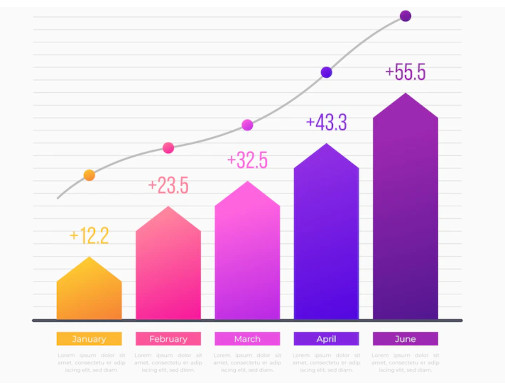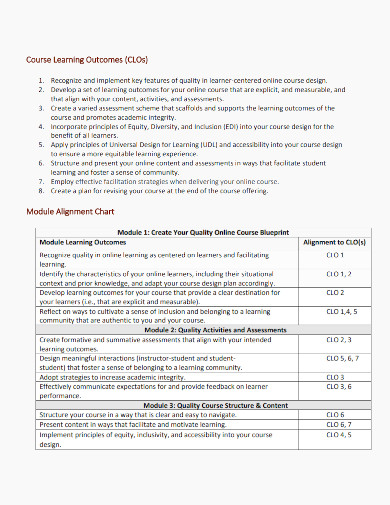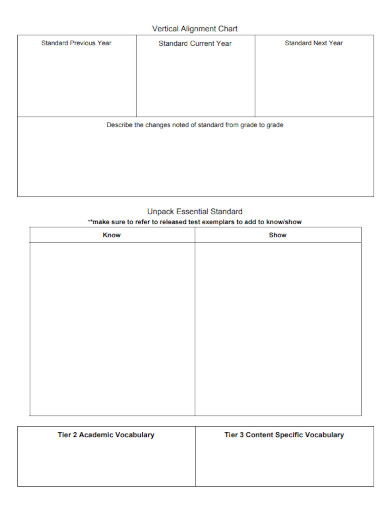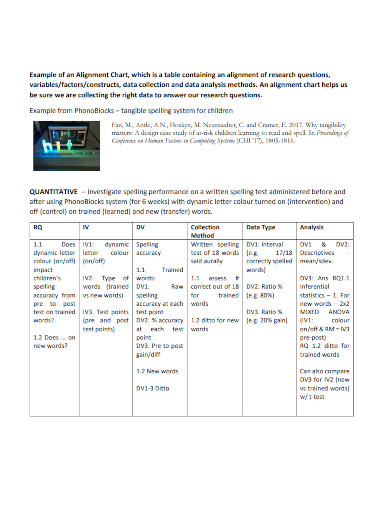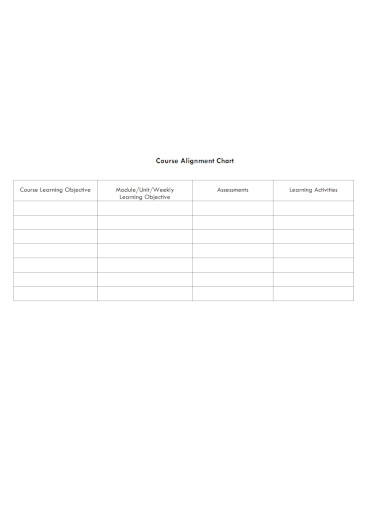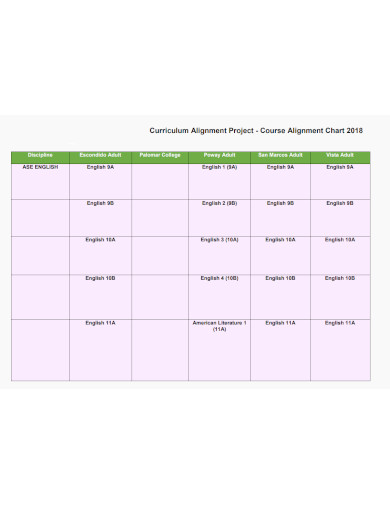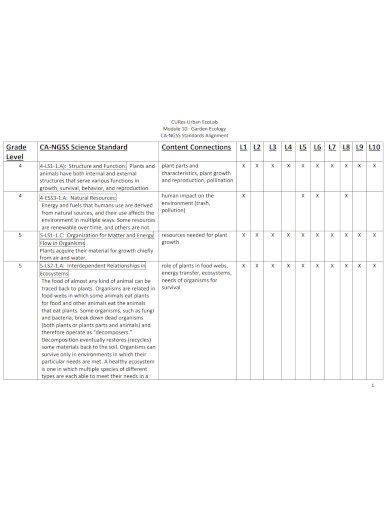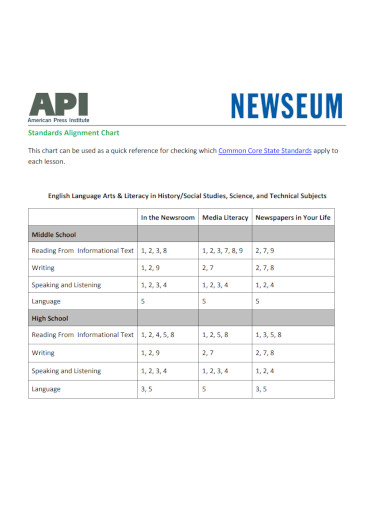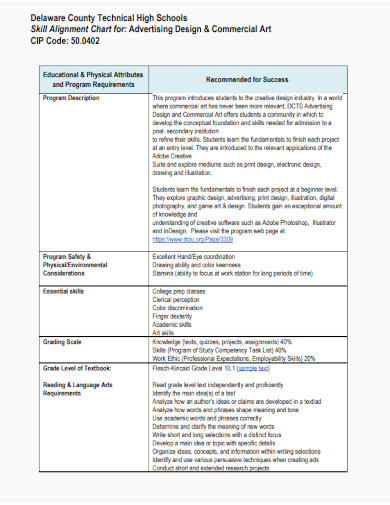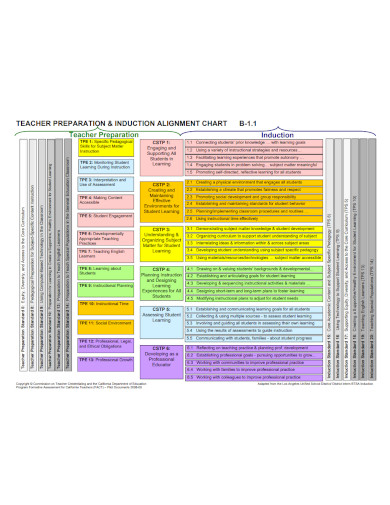A course alignment chart usually is a table or a matrix sample that comprises of two main columns/axes: one for the professional goals and objectives of the academic course and the other for the learning activities and joint assessments used to measure student progress towards those goals. Each row of the chart represents a specific goal or objective of the course, and the columns or cells in that row list the corresponding learning activities and assessments that will be used to help students achieve that goal.
10+ Alignment Chart Samples in PDF
1. Creating an Alignment Chart
2. Course Level Alignment Chart Template
3. Resource Alignment Chart Template
4. Vertical Alignment Chart Template
5. Example of Alignment Chart
6. Course Alignment Chart
7. Curriculum Alignment Chart
8. NGSS Standards Alignment Chart
9. Standards Alignment Chart
10. Skill Alignment Chart
11. Teacher Preparation Alignment Chart
What Is Alignment Chart?
Alignment chart refers to the relationship between the goals and evaluation objectives of a course and the learning activities and assessments used to measure student weekly progress towards those goals. A course alignment chart is a visual tool that can be used to show how different elements of the course are aligned with each other.
How To Make an Alignment Chart?
Creating a course alignment chart has several benefits. First, it helps instructors ensure that all elements of the course are aligned with the goals and objectives and that the learning activities and assessments are appropriate for helping students achieve those goals. This can help instructors identify and eliminate any gaps or inconsistencies in the course design and make sure the learning activities are aligned with the outcomes. Here are some general steps for creating a course alignment chart:
Step 1- Define Goals and Objectives
The chart should be based on the overall goals and objectives of the course. These goals and objectives should be specific, measurable, and aligned with the overall program and institutional goals.
Step 2- Key Topics
Identify the key topics and sample concepts that need to be covered in the course. The chart should include all of the key topics and concepts that students will be expected to understand and be able to apply by the end of the course.
Step 3- Specify Learning Activities
Determine the learning activities and assessments that will be used to measure student progress towards the goals and objectives. This can include things like lectures, readings, group projects, quizzes, exams, and other types of assessments.
Step 4- Create Chart
This can be done using a variety of tools, including pencil and paper, a spreadsheet program, or graphic design software. The chart should include the two main columns/axes: one for the goals and objectives of the course, and the other for the learning activities and assessments.
What is an alignment chart used for?
An alignment chart is most commonly used in fantasy settings, particularly in role-playing games such as Dungeons & Dragons. It is a visual representation of a character or being’s moral and ethical beliefs or alignment, it can also be used in other contexts as well, such as for analyzing characters or organizations.
How many categories are typically included in an alignment chart?
The most common alignment chart includes nine categories: Lawful Good, Neutral Good, Chaotic Good, Lawful Neutral, True Neutral, Chaotic Neutral, Lawful Evil, Neutral Evil, and Chaotic Evil. However, the number of categories can be adjusted as per the need.
How can a course alignment chart be used?
A course alignment chart can be used as a tool for instructors to ensure that their course is well-designed and aligned with the overall goals and objectives.
In conclusion, a course alignment chart is an important tool for instructors to ensure that the course is well-designed, organized and aligned with the overall goals and objectives. It’s a useful tool for planning, assessment, and communication. It’s a flexible and dynamic tool that helps instructors continuously improve the course and student learning.
Related Posts
FREE 8+ Blood Type Chart Samples in PDF | DOC
FREE 10+ Medicine Chart Samples in PDF | MS Word
FREE 10+ Seat Chart Samples in PDF
FREE 10+ Pie Chart Samples in PDF
Free 3+ Eye Color Chart Samples in PDF
FREE 10+ Family Chore Chart Samples in PDF
FREE 10+ Classroom Chart Samples in PDF
FREE 10+ Genealogy Chart Samples in PDF
FREE 10+ Shipping Chart Samples in PDF
FREE 10+ Goal Chart Samples in PDF
FREE 10+ Character Chart Samples in PDF
FREE 10+ Table Seating Chart Samples in PDF
FREE 10+ Classroom Seating Chart Samples in PDF
FREE 10+ Grade Chart Samples in PDF
FREE 10+ Workflow Chart Samples in PDF
